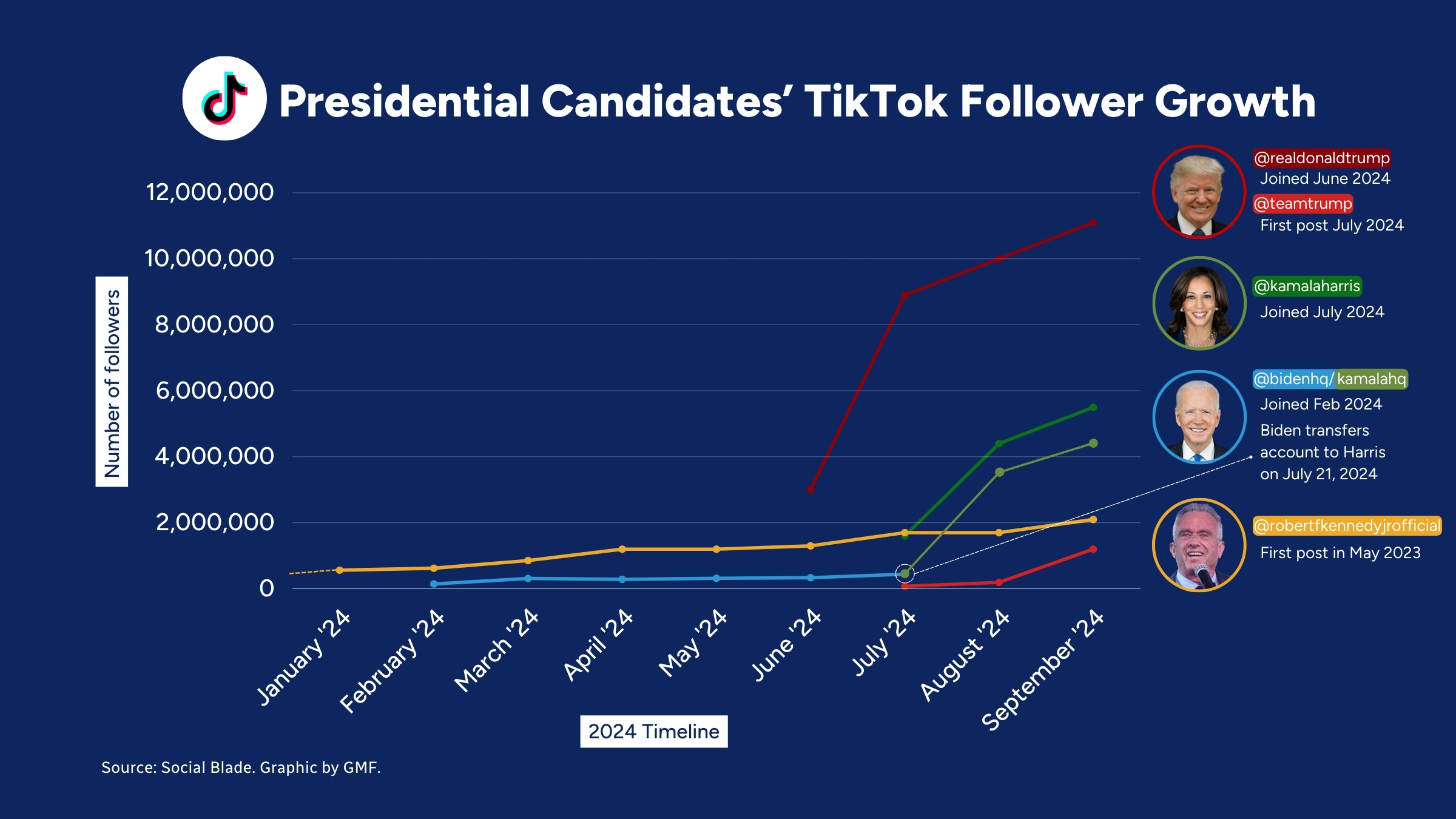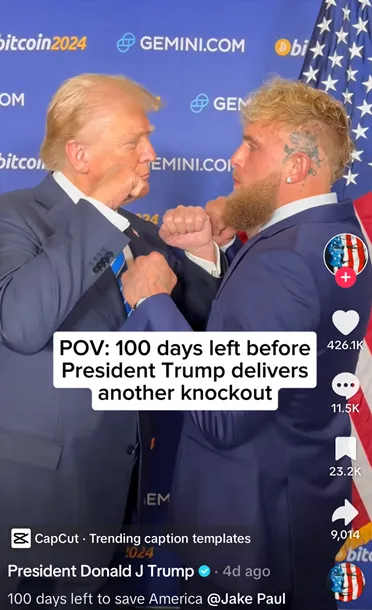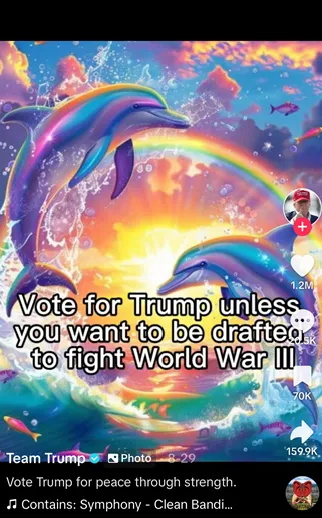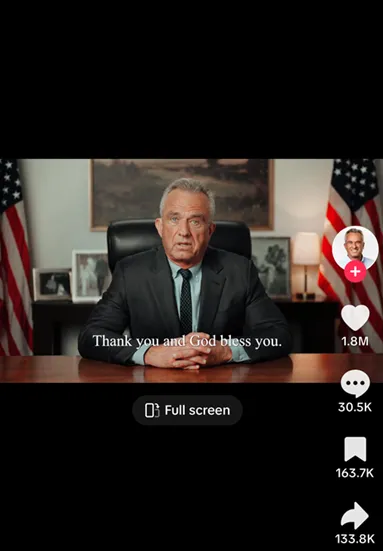TikTok in the 2024 US Presidential Race: Trending Campaign Strategy or Passing Trend?
The US presidential race has officially entered its “TikTok era”. Gone are the days of relying squarely on traditional campaign ads broadcast between news segments. Instead, with a third of American adults under 30 getting their news on the platform, top contenders have taken directly to their voters’ TikTok feeds to boost campaign visibility and take reputational jabs against opponents. Candidates and their teams churn out content that is often heavily coded in memes, pop culture references, and “netspeak”. Given TikTok’s reported 1 billion monthly active users worldwide, the app’s advent as an arena for political content in democracies was inevitable. Yet this spike in campaign activity stands in stark contrast to the growing recognition in Washington—including among presidential candidates themselves—that TikTok poses a national security threat due to its People’s Republic of China (PRC)-based ownership.
TikTok has already been banned on US government devices for data security reasons, and the American intelligence community has pointed to PRC attempts to influence elections through the platform. In April 2024, US President Joe Biden signed legislation that requires TikTok to divest from its parent company, ByteDance, by January 19, 2025, or face removal from the Google Play and Apple app stores—a de facto ban. TikTok and ByteDance filed suit in May to block the law, and the Department of Justice has since defended it by noting that “the serious national-security threat posed by TikTok is real.” An appeals court heard oral arguments on September 16, with the potential for an expedited ruling in December before the law takes effect.
Neither the uncertainty over TikTok’s future in the United States nor concerns that the PRC could put a thumb on the scale of US political debates through its algorithm have stopped presidential candidates from heading to the platform. In fact, the backdrop of precariousness has coincided with an uptick in energized campaign activity on the app. Candidates have deployed unconventional toolkits comprising memes, influencers, trending sounds, and pop culture branding to amass millions of followers and gain credibility among GenZ voters. While reposting content and maintaining a long-term online presence, as Robert F. Kennedy Jr. has done, may be an avenue for slow and steady growth, posts from Kamala Harris and Donald Trump that have driven a rapidly expanding following play directly into internet culture by capitalizing on the slang and humor of the youngest American voters. In 2024, the first—and maybe the only—chapter of presidential politics on TikTok, even the app’s critics may be the same faces that pop up the most on your feed.
Here is how the US presidential and vice presidential candidates are using TikTok:

Kamala Harris
Kamala Harris now has two TikTok accounts: her campaign inherited one from the Biden campaign (@kamalahq), and she launched another, personal account (@kamalaharris) on July 25.
Joe Biden/Kamala Harris Campaign
Joined TikTok: February 2024 (“bidenhq”) and July 2024 (account rebranded to “kamalahq”)
Follower count: 427,000 (for Biden when he dropped out of the race, compared to about 38 million on X and 17 million on Instagram at that same time); 4.4 million as of September, almost two months after the account transferred to Harris (compared to 21 million on X and 18.4 million on Instagram)
Likes: 134.2 million
Style: brat-coded and meme-driven
Types of posts: The Harris campaign account has received significant attention online, in part by capitalizing on a shoutout on X from popstar Charli XCX, who declared that “kamala IS brat” (playing off themes of Charli’s newly released album, “brat”, which contains songs that promote being carefree, bold, and unapologetic). In general, Harris’ content relies on trending sounds and pop culture references. The Biden campaign’s posts similarly focused on viral sounds and memes, in large part to take reputational jabs at Trump.
Notable Examples:
- Harris’ second post featured a slideshow of side-by-side images of Trump and her set to the track of “Femininomenon” by breakout pop singer Chappell Roan. https://www.tiktok.com/t/ZP8dur8Le/
- Harris’ posts are riddled with comments celebrating “Project Coconut”, a term that combines allusions to a viral sound bite of Harris referencing coconut trees in a speech with the Heritage Foundation’s “Project 2025” plan.
- One of Biden’s most popular posts, which garnered 1.2 million views, featured a still image of Trump containing the text “Dance or don’t commit 34 felonies” overlayed with a video, likely generated by artificial intelligence (AI), of Trump performing a viral TikTok dance to the song “Bop” by Big Boogie and DJ Drama. https://www.tiktok.com/t/ZP8duDCka/
Key themes: The campaign account frequently features clips of younger campaign staff taking jabs at Trump and his running mate, JD Vance, by stitching together videos and audio from their media appearances and interviews. The account also increasingly promotes Harris campaign videos and “fan edits” (stitched videos of Harris set to empowering music).
Kamala Harris (personal):
Joined TikTok: July 25, 2024
Follower count: 5.5 million (1.6 million within its first 16 hours)
Likes: 46.6 million
Style: empowered and music-driven
Types of posts: Harris’ personal account features professionally filmed content depicting the vice president making public appearances at political rallies, occasionally with celebrities, and debuting her running mate, Tim Walz.
Notable Examples:
- Harris posted footage from a rally in Detroit, set to Beyoncé’s hit song, “Freedom”. The camera pans from Harris walking off the plane to a vast crowd of supporters. https://www.tiktok.com/t/ZP8dufpmW/
- One of Harris’ most popular post to date, which has garnered 34.3 million views, features a clip from a political rally and is set to Kendrick Lamar’s “Not Like Us”, in which Harris challenges Trump to a debate and declares “If you’ve got something to say, say it to my face.” https://www.tiktok.com/t/ZP8dudKXo/
Key themes: Harris’ personal posts often feature content that uses scenic shots and empowering music to create impressions of power and momentum. While the account plays with TikTok-centric themes, including by using trending sounds and selfie-style celebrity endorsements (including from America Ferrera and Megan Thee Stallion), Harris’ personal account does not rely on memes that “kamalahq” does.
Position on TikTok’s future: In keeping with the position of the Biden administration, the Harris campaign has said to Axios that “We don’t want to ban TikTok. … We would just like to see a change in ownership.” Harris herself has cited “very important” benefits to the platform and national security concerns linked to its ownership.
Donald Trump
Like Harris, Trump has created two TikTok accounts: his personal account (@realdonaldtrump), and a campaign account (@teamtrump).
Donald Trump (personal)
Joined TikTok: early June 2024
Follower count: 11.2 million as of September (compared to 90.8 million on X and 26.6 million on Instagram)
Likes: 49.6 million
Style: dramatic, influencer-focused, and sloganized
Types of posts: Trump’s posts often feature shorter sound bites and slogans from speeches and public engagements overlayed with videos of his appearances and interaction with voters at events and campaign rallies. Trump’s posts have also heavily featured influencers Logan and Jake Paul, whose TikTok followings stand at 18.7 and 18 million, respectively.
Notable Examples:
- One of Trump’s posts features a sound bite from a campaign rally in which he declares “Kamala, you’re fired”, a nod to a catchphrase he popularized during his time on the reality TV show “The Apprentice”. https://www.tiktok.com/t/ZP8dudwhQ/
- In another post, Trump uses a slightly shorter, meme-driven format. The video features Trump facing off against influencer Jake Paul in a boxing stance, with the overlayed text “POV: 100 days left before President Trump delivers another knockout”.
Key themes: Trump’s early TikTok content relied on Ultimate Fighting Championship (UFC) imagery, perhaps in an attempt to cater his social media branding toward an image of physical strength. Since Harris’ announcement of her candidacy, Trump’s TikTok has also increasingly featured anti-Harris sound bites.
Donald Trump (campaign)
Joined TikTok: unknown (date of first post is July 27, 2024)
Follower count: 1.2 million as of September
Likes: 22.1 million
Style: Trump’s campaign account mirrors that of @kamalahq and its relationship to Harris’ personal @KamalaHarris account. While Trump’s two accounts contain similar substantive themes (e.g., poking fun at Harris and Walz, and tax policy), his campaign account often takes a looser and more humorous approach in its posts, with formats and language adapted to internet humor and TikTok trends.
Types of posts: Trump’s campaign account features a range of content, from standard campaign highlights, such as reposts of media interviews and his debate appearance, to sharply contrasting memes with policy messages and key platform stances in a playful and flippant style.
Notable examples:
- One popular post on Trump’s campaign account has racked up 7.6 million views. It features an image of two tricolored dolphins jumping over a rainbow with overlayed text: “Vote for Trump unless you want to be drafted to fight World War III”. The lighthearted track of “Symphony” by Clean Bandit plays in the background.
Key themes: Trump’s campaign account content leans into imagery of the former president as a “playful” candidate, with several videos of him dancing in his signature style, posing for the camera, and even advertising a “Trump Era” shirt in reference to Taylor Swift’s “Eras” tour (even after her endorsement of Kamala Harris). The account also uses imagery of physical strength and power curated on his personal account by relying on intense background music and sports visuals (one post refers to the first Harris-Trump debate as “gameday”), all while retaining a focus on undermining positive perceptions of Harris and Walz.
Position on TikTok’s future: During his administration, Trump tried to ban TikTok in the United States by issuing Executive Orders 13942 and 13943. These efforts were ultimately discontinued due to extended court battles and reversed by Biden via his own executive order. In June, Trump reversed his view on the platform, claiming that Facebook was a greater threat to national security and that “young kids … will go crazy without [TikTok].” On joining TikTok, he said “It’s my honor.”
Robert F. Kennedy, Jr
Joined TikTok: unknown (date of first post is May 12, 2023)
Follower count: 2.1 million as of September (compared to 3.8 million on X and 2.8 million on Instagram)
Likes: 45.3 million
Style: eccentric, with policy references
Types of posts: While Robert F. Kennedy Jr. officially suspended his presidential campaign and endorsed Donald Trump on August 23, his account is notable for its early emergence, consistency, and eccentricity. It is, in part, a vessel to repost more “traditional” campaign advertisements and video as well as content that advertises his authentic views and perspectives. His feed features professionally filmed clips of interviews, political rallies, and campaign ads. The content is often cross-posted on his Instagram feed. Kennedy’s posts are often curated to be easily digestible, with text boxes displaying explanatory titles that summarize the content of a video that may be policy focused (“If Elected, Here’s How I’ll Fix the Border”) or target political opponents (“Is Biden In Charge?” and “Biden’s Decline”). Other videos focus on his personal philosophies and communication style (“The Stoic’s Path” and “How Nature Connects Us to God”).
Notable Examples:
- One of Kennedy’s highest-viewed pieces, which is pinned to the top of his feed and has grossed 13.8 million views, is a simple repost of a campaign advertisement in which he addresses voters and lays out key policy stances. The video is professionally formatted.
- Kennedy’s frequent jabs at Biden have now shifted to Harris. One is a repost of a media interview, conducted on “Fox and Friends”, in which he argues that Harris has “some serious explaining to do” after she “was telling the American public [that] there’s no signs of [Biden’s] cognitive impairment”. https://www.tiktok.com/t/ZP8duyJ1b/
Key themes: Described as the “terminally online” candidate, Kennedy conducted much of his campaign on social media with predominantly policy- and endorsement-oriented content. On TikTok, he speaks to campaign platform positions (his support for treaties on AI, ending “forever wars”, and promoting environmental policies) and criticizes opponents. His anti-Biden content focused heavily on the president’s state of health and fitness for a second term. Beyond policy positions, Kennedy reposts celebrity and influencer endorsements, shares his appearances on podcasts and interviews, and promotes content embracing his eccentric style. One post features him with a praying mantis on his ear to indicate his support for regenerative agriculture. Another shows him discussing his interest in watching the ravens on his porch, with the caption “More unity. More ravens.” Notably, Kennedy has also used TikTok for longer-form, live voter outreach. In July he collaborated with platform influencers on a “TikTok Town Hall”.
Position on TikTok’s future: Kennedy has been supportive of TikTok’s ability to contribute campaign value despite stated “reservations” about the platform. He has been dismissive of the national security concerns related to TikTok’s PRC-based ownership, arguing that they are a “smokescreen” and that “Congress and the administration … want to screw [young Americans] over.”
Tim Walz and JD Vance
Joining the presidential candidates’ quick gravitation toward TikTok, two vice presidential candidates, Tim Walz and JD Vance, jumped on the platform in August and debuted with varying degrees of success.
Walz joined TikTok on August 16 and has since garnered 6.7 million likes and 1.5 million followers, just ahead of his 1.2 million followers on X but below his 1.8 million followers on Instagram. Walz’s TikTok presence has focused on expanding branding that has earned him a reputation as “everyone’s Midwestern dad”. His posts feature him crooning over dogs, trying a Nebraskan “runza”, and exchanging handshakes with Pennsylvania’s Aliquippa High School football team. While it does not feature kamalahq’s internet humor and meme-speak, Walz’s TikTok account has still grown substantially. It reached 1 million followers after just its first three days. The first post featured the Minnesota governor in casual clothes at a park with his dog, speaking for a few seconds about his premiere on “TimTok”. The post garnered 7.4 million views as of early September 2024.
JD Vance joined TikTok just two weeks before Walz did. His account has taken a different tack, with posts that focus less on his own positions and more on his opponents. Three of Vance’s four posts feature him in interviews or at public appearances, taking jabs at Walz’s and Harris’ policy positions. Only his first post has deviated from this trend, with a clip from a full interview with Nelkboys, a Canadian-American YouTube channel with which Trump has partnered. On it, Vance is welcomed to TikTok with a pack of hard seltzers. While the collaboration was a part of the “Send the Vote” initiative, a $20 million program aimed at increasing voter turnout among young men, Vance’s TikTok has not enjoyed immediate success among youth who form the platform’s base. His follower count reached only 866,300 and his likes stood at 2.8 million as of early September 2024, a mediocre showing compared to that of his Democratic counterpart. Comments on Vance’s first post often poke fun at him through false rumors spread about the contents of his memoir. Vance’s X following of 1.9 million largely overshadows his TikTok presence.
Passing Trend or Trending Strategy?
This year’s rush of presidential candidates and their running mates to TikTok is redefining the ways political office-seekers interact with key voter bases, despite the backdrop of national security concerns mounted by federal oversight and the candidates themselves. This shift is visible in presidential campaigns of all sizes, including those of third-party candidates Jill Stein and Marianne Williamson. Despite comparatively smaller followings (Stein at 71,600; Williamson at 549,800), content posted to their accounts has still gained traction (Williamson’s account boasts 6.6 million likes).
The move to TikTok is a drive to reach America’s youth. Yet whether virality on TikTok translates into votes at the ballot box remains to be seen, especially in a segment of the electorate with historically low voter turnout. As debates rage over the app’s future in the United States, presidential politics may now be an inevitable part of the calculus.




